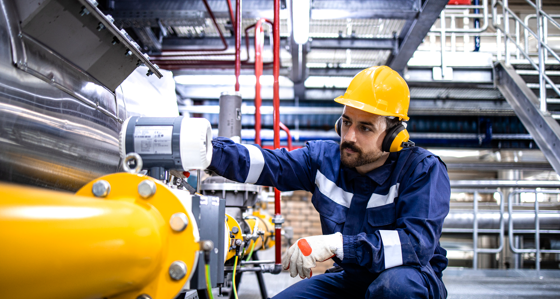The invasion of Ukraine transformed Russia’s relationship with Europe. How has this impacted the role of natural gas in the energy transition?
The role of natural gas in the energy transition has traditionally been based on it being an affordable, lower-carbon alternative to oil and coal. More recently, these same features have helped to position natural gas as a reliable back-up source of energy to complement the intermittency of renewables.
In the current global geopolitical environment, there has been a profound shift – both in the flows of natural gas and in how it is perceived. Energy security has moved up policymakers’ agendas and spot-priced gas is not currently an affordable option for many countries.
Baringa’s Global Gas Outlook suggests that until the next wave of liquefied natural gas (LNG) supply becomes available during 2026-2028, global natural gas consumption will continue to fall below what was previously expected, coinciding with delays in coal phase-out.
This raises questions about whether gas’s role in the energy transition has changed, what types of decarbonisation pathways it can support, and how it can enable adjacencies with energy solutions such as low-carbon fuels, hydrogen and CCUS.
These were the questions put to our panellists in Baringa’s Future Energy & Utilities Leaders Network event, held at St. Ermin's Hotel in London. Given the complexity of the issues involved, we brought together a mix of industry and academic experts to provide their insights and perspectives and we were honoured to host Al Tucker, GM CCUS Europe from Shell, Andrew Walker, VP Strategy from Cheniere and Anne-Sophie Corbeau, Global Research Scholar at the Center on Global Energy Policy, Columbia University.
Our speakers helped to guide a fascinating discussion, moving between many interrelated areas on the future of gas and the uncertainties that surround it. The key takeaway? While all the speakers acknowledged how challenging it is to make predictions in such a volatile and fast-changing landscape, they unanimously agreed that natural gas has a crucial role to play at a global scale.
The significance of natural gas will depend on geography, individual market requirements, and decarbonisation pathways and policies
While demand for natural gas has grown steadily over the past three decades, this trend is not expected to continue indefinitely. The consensus view is that natural gas demand growth at the global level will slow before it eventually plateaus and then falls.
The extent and timing of this change, however, depends on various factors. In more developed economies, where decarbonisation targets and plans are being established, natural gas demand will decrease sooner.
This shift is particularly evident in Europe, where sustainability ambitions have been boosted by security of supply targets after recent gas supply challenges. In these economies, the pace at which decarbonisation targets are being met will impact how much and for how long natural gas is going to be needed. If the world proceeds with decarbonisation at a slower pace, natural gas will continue to have a role in avoiding a disorderly energy transition with unintended consequences.
Different regions are at various stages along the decarbonisation path. In South and Southeast Asia, for instance, coal remains the dominant energy source, with gas likely to be the lower-carbon replacement. Renewables will develop rapidly alongside them.
Energy demand is projected to rise substantially in developing economies. And given the sensitivity of these regions to energy prices, natural gas will play a significant role in providing affordable energy.
Many African countries, meanwhile, have not experienced improvements in energy access per capita over the years. They now urgently need affordable solutions that can help them to meet their energy needs and ensure equity in the energy transition. Because natural gas provides one such solution, its use could be sustained for longer.
The role of natural gas evolves over time…from displacing coal to facilitating hydrogen production and enhancing electricity grid resilience
The role of gas will evolve over time. Using it to replace oil products and coal will immediately reduce carbon emissions in the short term (gas has far lower carbon intensity than either oil or coal). And in African countries with untapped gas resources, gas industry developments can not only alleviate access to energy but also boost economic growth and wider societal welfare.
Looking ahead to the medium to longer term, advances in Carbon Capture and Storage (CCS) technology offer a promising avenue for hydrogen production derived from natural gas or the continued consumption of natural gas itself. Developments here hold out great potential in helping to achieve the substantial targeted levels of hydrogen capacity required in a net-zero energy future.
In countries with high penetration of renewables, gas will continue to lose its share as a major source for power generation. That said, as the need for increased renewable energy capacity persists, the role of gas-fired power plants remains crucial to address the intermittent nature of renewables.
In this context, the role of gas shifts towards providing resilience to the electricity grid by ensuring stable and reliable power supply during periods when renewable sources may not be fully available. The progress being made in storage technologies and demand-side management will play a crucial role in determining the level of gas required for grid resilience.
Reaching net zero is a monumental challenge and all avenues should remain on the table.
Achieving the net-zero target is a formidable challenge and we are currently falling behind in meeting this goal. While the power sector has made significant progress in decarbonisation due to the plummeting costs of renewable energy, other sectors still lack viable solutions.
Hydrogen appears to be a preferred substitute for gas in hard-to-abate sectors (e.g. heat). However, if hydrogen production will rely solely on electrolysis, the immense amount of renewable capacity required becomes apparent. This underlines the importance of including alternatives, such as hydrogen production from natural gas coupled with CCS, as an integral part of the solution.
It is important to remember that, in addition to ensuring a sufficient supply, generating demand for alternative energy sources presents another critical challenge. Take the industrial sector, for example. Hydrogen needs to become cost-competitive with gas to incentivise industries to transition to alternative production technologies and replace gas with hydrogen.
In addition to hydrogen production costs, significant questions arise over its transportation. This can double the cost of hydrogen when it is moved over long distances. While various options have been proposed, such as transporting it in the form of ammonia or liquefied hydrogen, none has yet proved to be a definitive solution.
The establishment of a global market for hydrogen is another factor. After all, it took around 60 years for the LNG market to become relatively liquid (it remains dominated by long-term contracts). While we can learn from this experience, it is crucial to be realistic about the time it will take to establish a similar market for hydrogen.
All of this suggests that we need to keep every option open in the search for solutions to the net-zero challenge. One of these options is natural gas with CCS. Globally, there are plentiful reserves of natural gas, and LNG offers a convenient way of transporting it from suppliers to buyers.
Gas decarbonisation through CCS, which is at its early stages in Europe, will require deep cross-governmental collaboration, regulatory alignment and political support
Europe has only recently begun to gain momentum in its investment into CCS. The industry remains in its infancy and the involvement of governments is pivotal to mitigating risks and accelerating commitments. Although there are existing mechanisms in place, they are currently insufficient to incentivise the level of investment required.
Identification of the most suitable sites for carbon storage is a complex and challenging issue. In Europe, there is an imbalance between countries that contribute the most to CO2 emissions and countries with significant storage potential.
It seems that the most effective way will be to capture carbon from where it is mostly produced and store it in the most cost-effective locations. Achieving this goal will demand a more interconnected Europe, with the necessary infrastructure in place to facilitate the free trade and transportation of carbon.
The old oil and gas basins in the North Sea present a promising option for CO2 storage. Approximately 80% of these basins are distributed equally between UK and Norway, with the balance in the EU. While technological improvements will foster a safe and positive outlook, deep cross-governmental collaboration, regulatory alignment, and political concessions are all essential.
A sustainable and equitable Plan B – recognising the role of natural gas – is needed to manage the risk that decarbonisation targets are missed and the consequent disorderly transition results in a worst-case scenario for meeting the demands of the energy trilemma
Natural gas has played a major role in reducing carbon emissions in many countries by replacing more pollutant fossil fuels. The extent of this role in the future depends on the development of clean technologies.
If other technologies provide an affordable and scalable solution in the short term, there will be increased opportunities for power to switch directly from coal to renewables. But a slower deployment of renewables could extend coal use, particularly if investment in natural gas falls.
For heat, the pace of hydrogen or other zero-carbon solutions is even more uncertain. To avoid a disorderly energy transition and the potentially significant consequences of clean technologies not developing as expected, we need to think about a sustainable plan B.
The current perception of the market around long-term gas demand will drive investment decisions. This will, in turn, impact the security of gas supply and its affordability into the future. A coherent approach to necessary natural gas investments is critical.
Europe has been sending mixed messages on natural gas, before and after the Russian invasion of Ukraine. There has been a reluctance to support developing countries in both commercialising gas reserves and then, following the gas supply challenge, in seeking additional LNG supplies for Europe.
And despite benefiting from imports of LNG, European buyers have been hesitant to commit to long-term LNG contracts. As well as placing future volume risk on participants in other markets, this will impact medium-term investments in gas and its long-term availability and pricing.
The record high gas prices in 2022 prompted a historical return to coal. LNG cargoes were redirected towards Europe where governments can pay higher prices to secure gas supply. This left other countries without access to gas, and compelled them to rely on more polluting fossil fuels to meet their energy needs – or fail to meet energy demand at all. Even in Europe, the consumption of coal and petroleum products increased, leading to the second-highest year of global coal consumption in history.
While the circumstances that led to this situation were exceptional and unlikely to repeat at that level, it demonstrates the destabilising effects of a disorderly transition. The key message? To avoid further disorder we need to think how the energy system will respond and the role that natural gas will play if we’re unable to hit net- zero targets by 2050.
It is clear that natural gas will remain a key part of the energy mix for decades to come. Its role should be proactively managed to avoid the risk of further unforeseen consequences and a disorderly transition.
A huge thank you to Andrew Walker, Anne-Sophie Corbeau, and Al Tucker for participating in the panel session at our event, and to all the Baringa clients and guests that attended.
Our Experts

Related Insights

Commodities and energy trading video series
Join us as we delve into key areas that are shaping the trading industry
Read more
Navigating risk: insights into the complexities and challenges of LNG trading
We have highlighted some key challenges related to complexity of LNG trading which Risk Managers of trading organisations must deal with.
Read more
Digital transformation and decarbonisation in the energy sector
Energy leaders are using digital technologies and data to fast-track their journeys to decarbonisation.
Read more
Unveiling the cost of capital: navigating financial terrain in energy/commodity trading
In this article, we'll explore why cost awareness and transparency are important and provide some thoughts on cost of capital allocation.
Read more